Compensation or Refund Email to Customer
Subject: Regarding Your Recent Purchase - Compensation or Refund Options
Dear [Customer's Name],
I hope this email finds you well. We would like to express our sincere apologies for any inconvenience you may have experienced with your recent purchase from [Your Company Name]. Our commitment to providing high-quality products and exceptional customer service is of utmost importance to us, and we deeply regret that we fell short of your expectations on this occasion.
After carefully reviewing your case, we have identified the issue and want to make it right for you. We understand the frustration and disappointment this may have caused, and we are committed to resolving the matter to your satisfaction.
To rectify the situation, we are offering you two options:
1. Compensation: We would like to offer you [details of the compensation, e.g., store credit, discount voucher, free upgrade, etc.]. This compensation is a token of our apology and appreciation for your understanding.
2. Refund: If you prefer, we are more than willing to provide you with a full refund for your purchase. We understand that sometimes a refund is the most appropriate resolution, and we want to ensure you are completely satisfied with your experience with us.
Please let us know which option you would prefer, or if you have any other specific solution in mind. Our goal is to make this right for you, and your feedback is essential in helping us improve our products and services.
To proceed with either option, simply reply to this email or get in touch with our customer support team at [customer support email/phone number]. Please include your order number or any relevant details, so we can process your request promptly.
Once again, we extend our sincerest apologies for any inconvenience caused. Your satisfaction is our top priority, and we are committed to resolving this matter as swiftly as possible.
Thank you for your understanding and patience. We value you as a customer and look forward to regaining your trust in our brand.
Best regards,
[Your Name]
[Your Title/Position]
[Your Company Name]
[Contact Information: Email, Phone]
Professional Compensation Email to Customer
Subject: Compensation for Your Recent Experience
Dear [Customer Name],
We sincerely apologize for the inconvenience you experienced with [Product/Service]. To make amends, we are issuing a compensation of [Amount or Description] to your account.
Please allow 3–5 business days for the transaction to reflect. We value your business and hope to serve you better in the future.
Thank you for your understanding.
Best regards,
[Your Name]
[Company Name]
Refund Email for Faulty Product
Subject: Refund for Your Purchase
Dear [Customer Name],
We are sorry to hear about the issues you encountered with [Product Name]. As a resolution, we have processed a full refund of [Amount] to your original payment method.
Please note it may take 5–7 business days for the refund to appear in your account. We apologize for any inconvenience and appreciate your patience.
Sincerely,
[Your Name]
[Company Name]
Heartfelt Apology and Compensation Email
Subject: Our Apologies and Compensation
Dear [Customer Name],
We deeply regret the inconvenience caused by [Incident/Issue]. As a gesture of goodwill, we are providing [Compensation/Discount/Voucher] to express our apologies.
Your satisfaction is important to us, and we hope this resolution meets your expectations. Thank you for giving us the opportunity to make things right.
Warm regards,
[Your Name]
[Company Name]
Quick and Simple Refund Email
Subject: Refund Processed
Dear [Customer Name],
Your refund for [Product/Service] has been processed and should reflect in your account within 3–5 business days.
We apologize for the inconvenience caused and thank you for your understanding.
Best,
[Your Name]
[Company Name]
Casual Customer Compensation Message
Hi [Customer Name],
Sorry for the trouble with [Product/Service]. We've credited [Compensation Amount or Voucher] to your account as a token of apology.
Thanks for sticking with us!
Cheers,
[Your Name]
[Company Name]
Official Refund and Compensation Email
Subject: Official Refund and Compensation Notification
Dear [Customer Name],
Following your recent complaint regarding [Product/Service], we have approved a refund of [Amount] and an additional compensation of [Description].
This has been processed and will reflect within 5 business days. We apologize for any inconvenience and remain committed to your satisfaction.
Sincerely,
[Your Name]
[Company Name]
Provisional Compensation Email
Subject: Temporary Compensation Arrangement
Dear [Customer Name],
While we investigate the issue with [Product/Service], we are providing a provisional compensation of [Amount/Service] to minimize any inconvenience.
We will update you once the final resolution is complete. Thank you for your patience.
Best regards,
[Your Name]
[Company Name]
FAQ about Compensation and Refund Emails
Q: How long does it take to process a refund?
A: Typically 3–7 business days depending on the payment method.
Q: Can compensation be in the form of a discount or voucher?
A: Yes, depending on company policy, it may be offered as a voucher, discount, or direct monetary refund.
Q: Do I need to respond to acknowledge receipt?
A: While optional, confirming receipt helps ensure there are no processing issues.
Q: Can I request an alternative compensation method?
A: Most companies allow requests, subject to approval.
What is a Compensation or Refund Email and Why You Need It
A compensation or refund email is a formal or semi-formal communication sent to a customer to acknowledge an issue with a product or service and provide a resolution.
Purposes include:
- Maintaining customer trust and loyalty.
- Providing a documented acknowledgment of the issue.
- Outlining compensation or refund clearly and professionally.
- Mitigating potential negative reviews or complaints.
Who Should Send a Compensation or Refund Email
- Customer service representatives.
- Account managers or support team leads.
- Company executives in cases of serious complaints.
- Any official staff authorized to approve refunds or compensations.
Whom Should the Email Be Addressed To
- The affected customer or client who filed the complaint.
- Secondary recipients if needed, such as account holders or supervisors.
- In corporate settings, CC the internal team for record-keeping.
When Should You Send a Compensation or Refund Email
- Upon confirmation of a defective or damaged product.
- After service failure or unsatisfactory experience.
- Following a customer complaint escalation.
- As a proactive gesture to prevent negative feedback.
- When policy dictates refunds or compensation for delays or errors.
How to Write and Send a Compensation or Refund Email
- Begin with a clear subject line reflecting the purpose.
- Open with a polite greeting addressing the customer by name.
- Acknowledge the issue and apologize sincerely.
- Clearly state the compensation or refund being offered.
- Include instructions for claiming or receiving it.
- Maintain a professional yet empathetic tone.
- End with gratitude and contact information for further support.
Formatting Guidelines for Compensation or Refund Emails
- Length: 2–4 concise paragraphs.
- Tone: Professional, empathetic, and clear.
- Style: Formal for serious complaints; casual for minor issues.
- Wording: Precise about amounts, dates, and procedures.
- Mode: Email is standard; printed letters for high-value or formal cases.
- Etiquette: Avoid blame, focus on resolution and reassurance.
Requirements and Prerequisites Before Sending the Email
- Confirm the amount or nature of compensation/refund.
- Verify customer account or purchase details.
- Obtain approval from management if necessary.
- Prepare clear instructions for refund or compensation delivery.
- Review company policy regarding compensations and refunds.
After Sending a Compensation or Refund Email
- Confirm that the customer received and understood the email.
- Track the processing of refunds or compensation.
- Respond to any follow-up questions promptly.
- Document the resolution in internal systems.
- Evaluate the situation to prevent recurrence of the issue.
Tricks and Tips for Effective Compensation or Refund Emails
- Personalize the email with customer name and order details.
- Respond promptly to enhance customer trust.
- Include an estimated timeline for processing refunds.
- Be concise yet empathetic in wording.
- Offer additional gestures like vouchers to strengthen customer loyalty.
Common Mistakes to Avoid in Compensation or Refund Emails
- Delaying the response to the customer.
- Providing unclear instructions or timelines.
- Using impersonal or automated language that lacks empathy.
- Failing to confirm refund or compensation processing.
- Overpromising compensation beyond company policy.
Elements and Structure of a Compensation or Refund Email
- Subject line clearly stating compensation or refund.
- Polite greeting addressing the customer.
- Acknowledgment of the issue or complaint.
- Apology for inconvenience caused.
- Detailed explanation of compensation or refund.
- Instructions for receiving or claiming it.
- Contact information for further support.
- Professional closing and signature.
Pros and Cons of Sending Compensation or Refund Emails
Pros:
- Maintains positive customer relationships.
- Mitigates negative feedback or reviews.
- Provides documented evidence of issue resolution.
- Enhances brand reputation for customer care.
Cons:
- May increase company costs.
- Could encourage repeated claims if abused.
- Risk of miscommunication if email is not clear.
Comparison with Similar Letters or Emails
- Apology Email: Focuses on acknowledging the issue; compensation email includes resolution.
- Promotional Email: Encourages sales; compensation email addresses a complaint or problem.
- Customer Service Follow-up: May request feedback; compensation email provides tangible remedy.
- Credit Note or Voucher Notification: Similar, but compensation emails can also include monetary refunds.
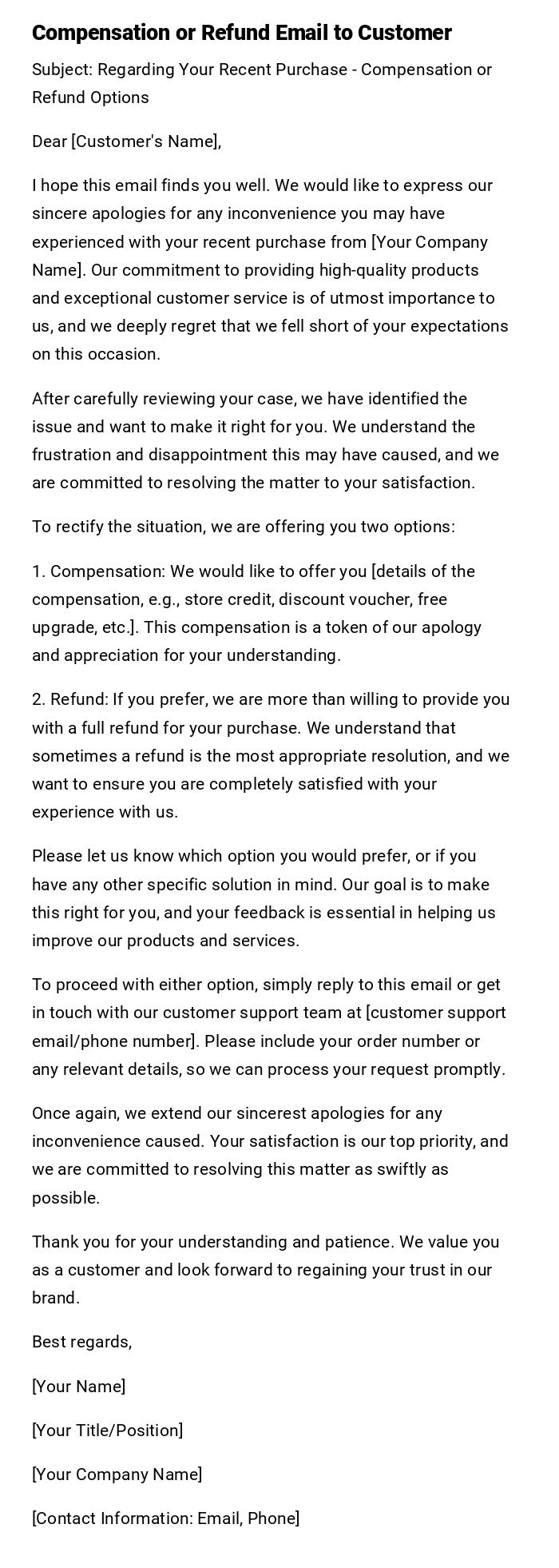
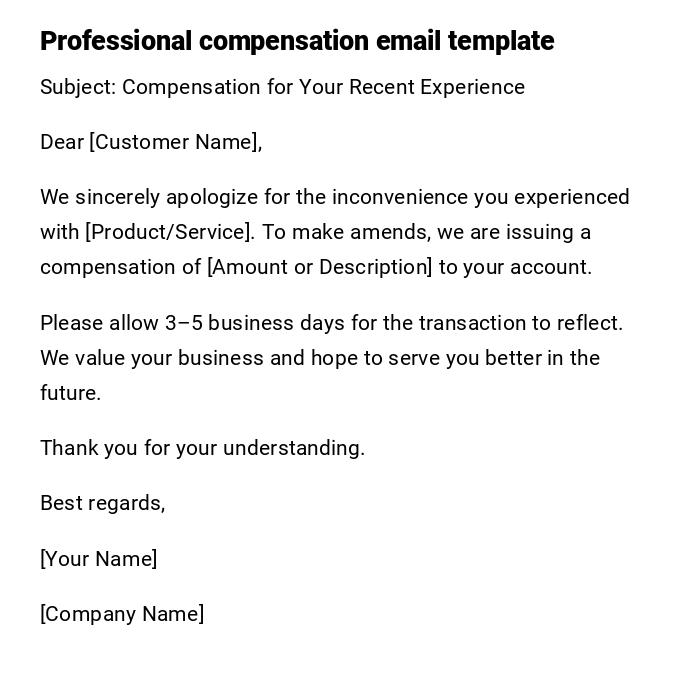
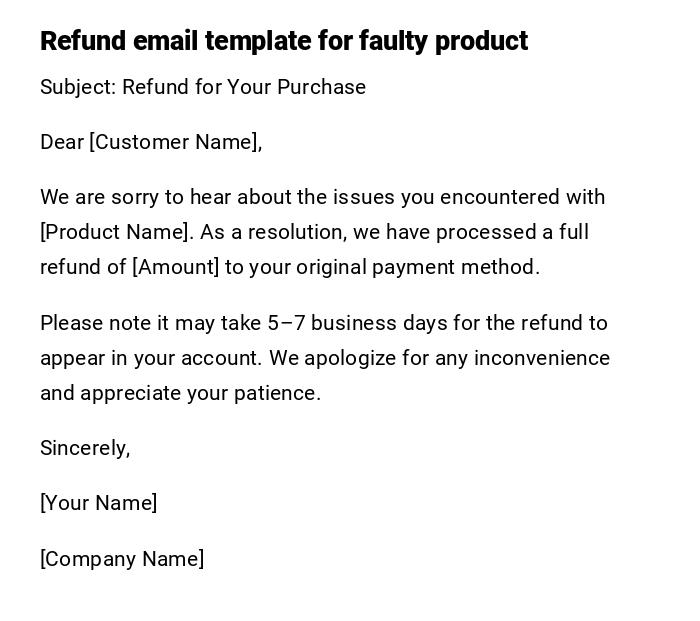
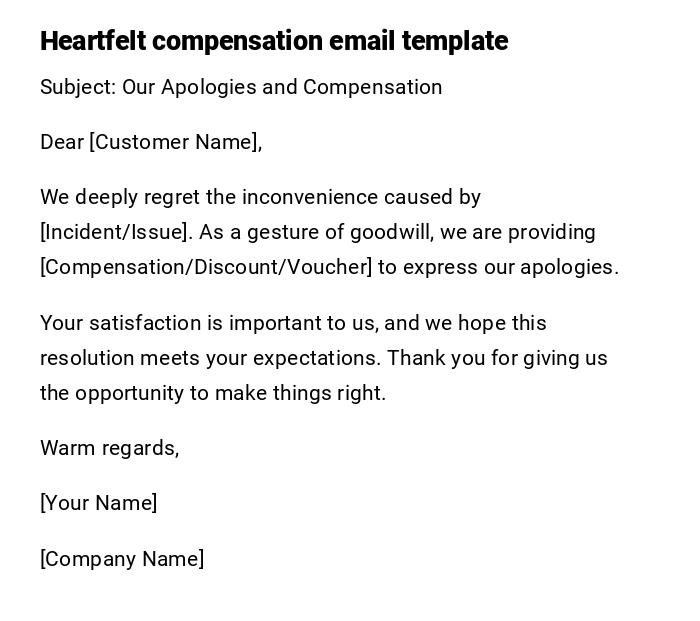
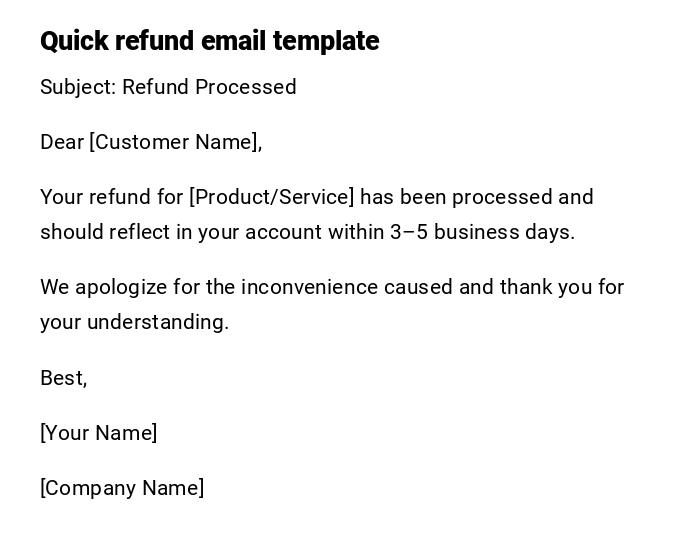
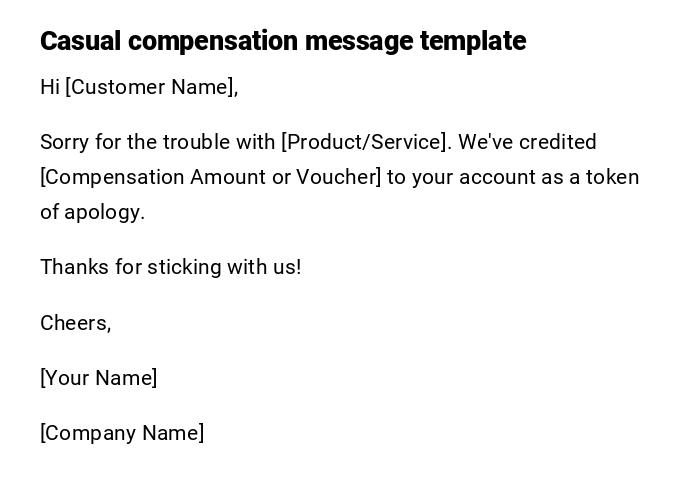
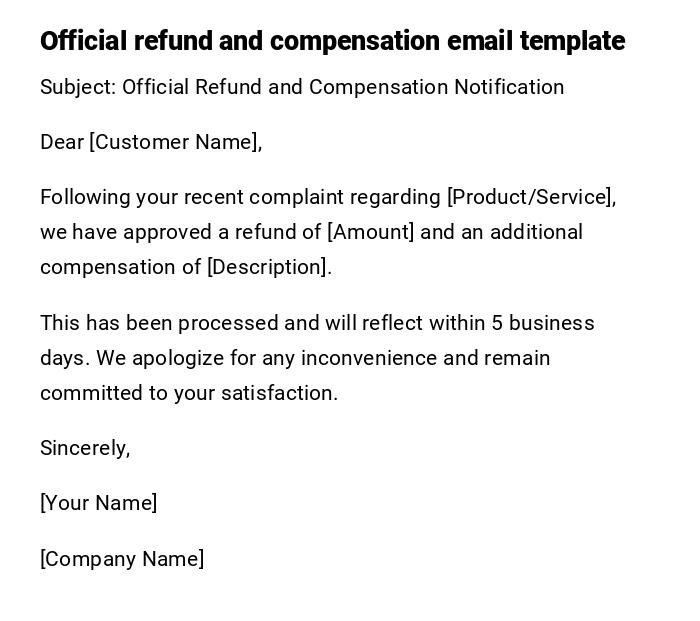
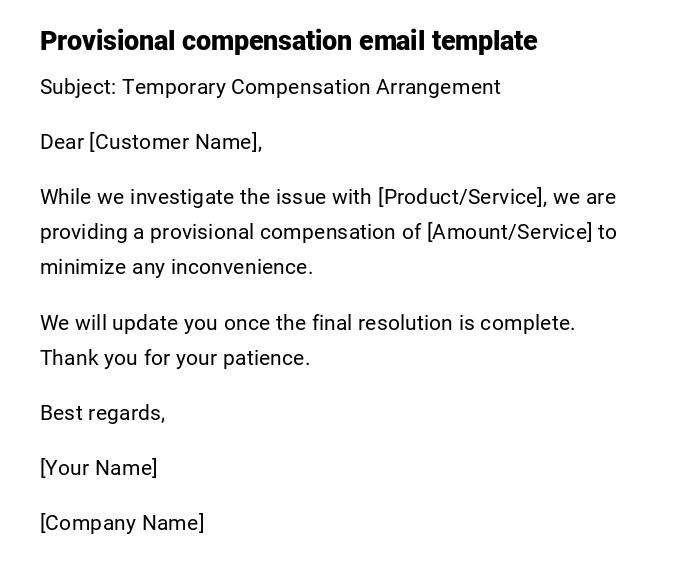
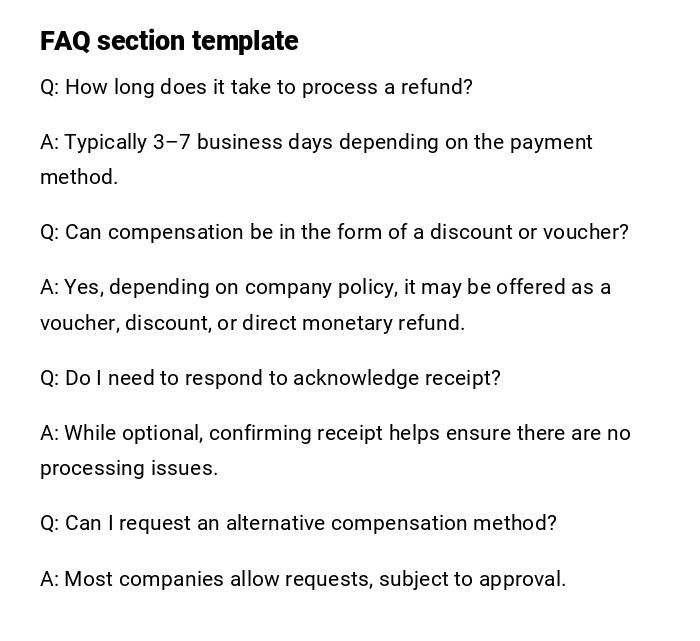

 Download Word Doc
Download Word Doc
 Download PDF
Download PDF